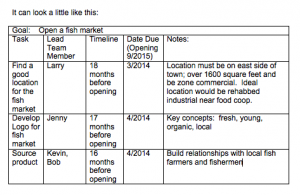How do you benefit as a company from a great brainstorming session?
Let’s say you got the gang all together. You gave them an email heads up a few days ahead of time so all the deep introverts in the group had time to think. You set the parameters for the quest and kept a positive, no criticism environment. The brainstorming session couldn’t have gone better and now you have a white board packed with ideas. What’s next? How does your business get better as a result?
The answer is in sequencing.
For any idea to be implemented you must develop a concrete sequence of events that will accomplish that idea.
Let’s say you’ve all agreed on one idea that came out of the brainstorming session. You are convinced it will positively influence your bottom line and your employees are excited about the idea.
What’s next? Simplified sequencing. For any idea to succeed – whether big or small, complex or simple – you must have a sequential implementation plan. It may have 5 steps or 500 steps, but you will never get there unless you identify the steps, plan the journey and get started.
- Identify the target date for implementing the big idea.
- Identify every step necessary, down to the most infinitesimal detail, necessary to implement said big idea.
- Arrange tasks according to sequence back up from your target launch date. You may want to use index cards or sticky notes for this part because this usually takes a little rearranging.
- Identify how much time each task will take and who will be responsible for accomplishing.
- Check your time line and adjust your opening date accordingly. If you have plenty of time, then identify the start date for the first task.
- Go! Work the plan.
- Set regular check-ins with everybody involved. Don’t micro manage along the way, but be sure everyone knows what is expected and when it is expected from the get go.
- Adjust then time line after each check in.
- Launch your idea.
- Evaluate process: discuss with each participant and review time line. This will not only improve your process for the next great idea, but will affirm employees in the process.
This approach becomes more complex, depending on the goal but it helps you layout a specific tactic for accomplishing a great idea. I’ve used it for everything from planning a kid’s birthday party to a community wide project for hundreds of volunteers, to communication strategies for a school district with 18 campuses.
Next time you decide to implement a great idea, try simple sequencing.
Otherwise, all those great ideas? They’ll just might just stay on the white board.


Leave a Reply